As an Amazon Associate, we may earn a commission if you make a purchase — at no extra cost to you.
4K TV vs 8K TV in 2025: Honest Comparison to Help You Buy Smarter
4K TV vs 8K TV — which one truly fits your home in 2025? In this complete 4k vs 8k tv guide, we compare features, picture quality, and costs so you choose smart without the hype. See real-world differences in picture quality, content, and cost so you choose the right upgrade without the hype.
When it comes to buying a new TV in 2025, the 4K TV vs 8K TV debate is hotter than ever, and many first-time buyers searching for a 4k vs 8k tv comparison are unsure which offers better value in 2025. With both options boasting stunning visuals, it’s easy to get caught up in the marketing buzz. But the real question is: should you future-proof with 8K, or stick with a proven and more affordable 4K? In this guide, we’ll cut through the noise, compare them in real-life use, and help you decide what’s truly worth your money this year.
📌 Why This Post Matters
- Most people waste money on TV features they never use—this guide shows what truly matters in real life.
- You’ll finally understand whether 8K resolution is worth it for your setup and viewing habits.
- No fluff, no jargon—just a beginner-friendly breakdown of what to buy in 2025 (and what to skip).
- Most reviews only compare numbers. This guide shows what actually matters for real-life viewing and budgets.
🎯 What You’ll Learn in the Next 5 Minutes
- 📺 The real difference between 4K vs 8K TVs—beyond the pixel hype.
- 🎞️ How content availability affects picture quality on both resolutions.
- 🛋️ How your room size, seating distance, and habits influence which TV is right for you.
- 💡 The most important features to look for in 2025 (and which specs to ignore).
- 💸 Which TVs are worth buying today—based on real-life use, not just numbers.
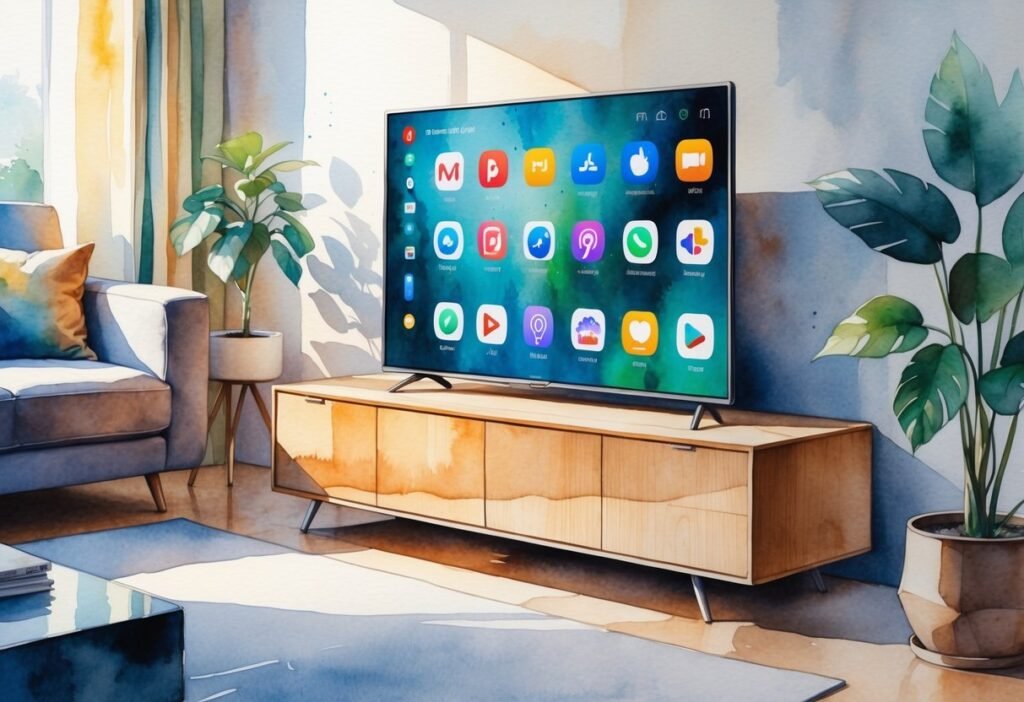
Let’s break down the real differences in 4K vs 8K TV features, benefits, and whether the upgrade truly matters in 2025. I’ll keep it honest and skip the hype, so you can figure out what’s really best for your space. If you just want to make a smart choice without getting lost in marketing nonsense, this review should clear things up and help you decide.
- Ultra-bright for daylight rooms
- AI upscaling makes 4K look sharper
- Reference-level contrast & color
- Perfect for movies & dim rooms
- OLED blacks + higher brightness
- Great for sports & gaming
Key Differences in 4K TV vs 8K TV for Real-World Viewing
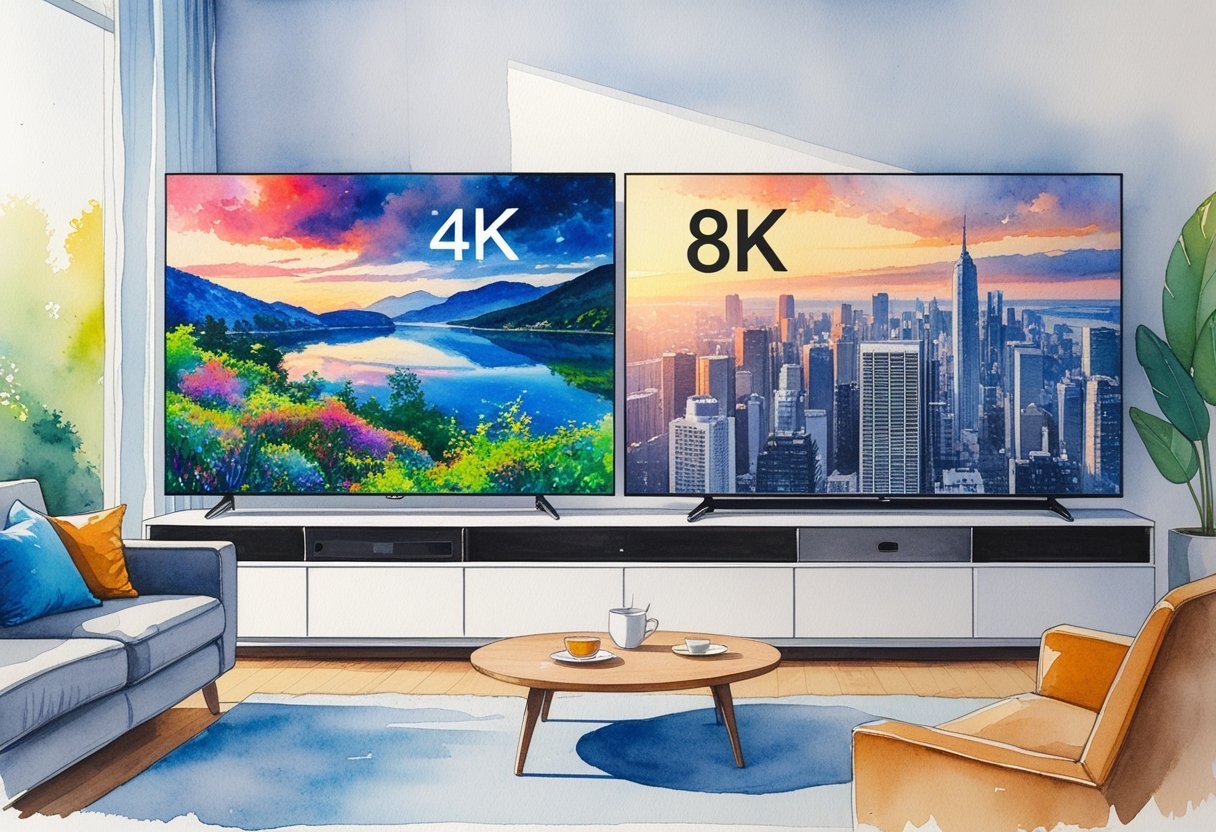
Both 4K TV vs 8K TV options deliver stunning visuals in 2025, but this 4k vs 8k tv comparison focuses on real-world viewing, not just spec sheets. But what separates them in real-life viewing? Before you buy, it’s smart to consider what’s actually available to watch, how the display looks in real life, and what real customers are saying.
Why a 4K TV Beats an 8K TV for Most Homes in 2025
In the 4K TV vs 8K TV battle, the 4K side delivers a crisp 3840×2160 resolution—making this 4k vs 8k tv showdown a clear win for budget-conscious buyers. That’s four times the detail of those old 1080p HDTVs. You’ll find 4K TVs everywhere now, in just about every size and price you can imagine.
They’re a great pick if you want sharp, clear images but don’t want to spend a fortune. 4K is basically the standard now for streaming, gaming, and regular TV. If you’re a family, a movie lover, or a gamer who just wants something that looks great and doesn’t break the bank, 4K is really the sweet spot.
- OUR MOST ADVANCED 4K AI PROCESSOR: Powered by 128 neural networks to deliver AI-enhanced picture and…
- SAY GOODBYE TO DISTRACTING REFLECTIONS: Watch everything you love without distracting reflections so…
- POWERFUL BRIGHTNESS AND DRAMATIC CONTRAST FOR STRIKINGLY LIFE-LIKE PICTURE: See new details and…
Last update on 2025-11-12 / Affiliate links / Images from Amazon Product Advertising API
Why it’s ideal:
- Best 4K pick in our 4K vs 8K TV showdown—perfect balance of performance and price.
- Rtings.com ranks it as the #1 4K TV for overall performance in 2025.
- Stunning QD-OLED picture, ultra-low input lag, HDMI 2.1 support, and no glare make it perfect for beginners, gamers, and movie lovers alike.
📺 Looking for a stunning display without overspending? Check out our top-rated 4K TVs that combine performance and affordability.
→ See Best-Selling 4K TVs on Amazon
Most buyers are really happy with 4K TVs—they love the bright colors, the easy app access, and how simple it is to set up. Reviews and ratings back this up. A 4K TV is honestly a safe bet for almost anyone upgrading from an older set.
Should You Buy an 8K TV or Stick with 4K in 2025?
8K TVs pack in 7680×4320 pixels, so that’s four times the detail of 4K. The result? Super sharp pictures—at least on really big screens or if you sit pretty close. Brands like Samsung and LG are leading the charge, mostly with their fanciest, most expensive models.
In terms of 4K TV vs 8K TV buying decisions, 8K suits early adopters chasing future-proof tech, but for most shoppers comparing a 4k vs 8k tv, the content gap makes 4K the practical choice. But here’s the thing: most reviews warn that true 8K content is still rare in 2025. Most stuff you watch gets upscaled from 4K or even lower, and streaming services aren’t really offering much 8K yet.
🧠 Don’t fall for hype. Compare 8K models with real specs, pricing, and current deals before you invest in your next TV.
→ Explore Top 8K TVs with Reviews
- ENHANCED 8K CLARITY POWERED BY 256 AI NEURAL NETWORKS: Watch your content in astonishingly realistic…
- A SLEEK METAL DESIGN THAT BLENDS SEAMLESSLY INTO YOUR HOME: Sleek, yet functional design for a…
- ACCESS ART FROM WORLD-FAMOUS GALLERIES AND ARTISTS: Find the perfect piece of artwork from the…
Last update on 2025-11-12 / Affiliate links / Images from Amazon Product Advertising API
Why it’s ideal:
- Touted as the best current 8K model with Mini‑LED, top-tier upscaling and full HDMI 2.1 suite.
- The flagship that balances performance and value—perfect for tech enthusiasts ready to future-proof.
If you’ve got a luxury home theater, work in display tech, or just want to show off, maybe an 8K TV makes sense. For most homes, though, it’s not a must-have.
Gaming & Streaming: 4K TV vs 8K TV Performance in 2025
For gaming, pretty much all consoles and most gaming PCs support up to 4K with smooth frame rates. No big-name system is running games at native 8K, so all those extra pixels don’t really get used. Genre research and thorough reviews agree: For gaming setups, 4K vs 8K TV favors 4K due to better support and smoother performance.
When streaming in 2025, 4K vs 8K TV becomes a real consideration—most services max out at 4K, meaning a 4K TV vs 8K TV performance test for streaming often shows 4K as the winner in this 4k vs 8k tv matchup. If you’re into movies or sports, there’s tons of 4K content, and new stuff keeps coming out in that format.
- A treat for the eyes: Sharp 4K brings out rich detail on our 50″ flat screen TV, while colors pop…
- Explore a world’s worth of TV: Dive into all kinds of entertainment and easily find your favorites…
- A ton of entertainment at the best price—free: Your go-to streaming destination for free…
Last update on 2025-11-12 / Affiliate links / Images from Amazon Product Advertising API
Why it’s ideal:
- Budget-Friendly Smart Option.
- From Tom’s Guide/Business Insider as a strong budget QLED pick with Roku OS Business Insider.
- Affordable, easy to use, with good HDR, Bluetooth headphone mode, and VRR—excellent value under $500.
🎮 Want buttery-smooth gameplay and cinematic visuals? These smart TVs are optimized for PS5, Xbox, and more.
→ Shop Gaming-Ready 4K TVs
8K TVs might shine in fancy home cinemas, art displays, or public spaces, but honestly, for most living rooms, you won’t notice a huge difference. You really only see the benefit if you’re sitting close or have a screen bigger than 75 inches.
4K TV vs 8K TV: Streaming & Broadcast Content Availability
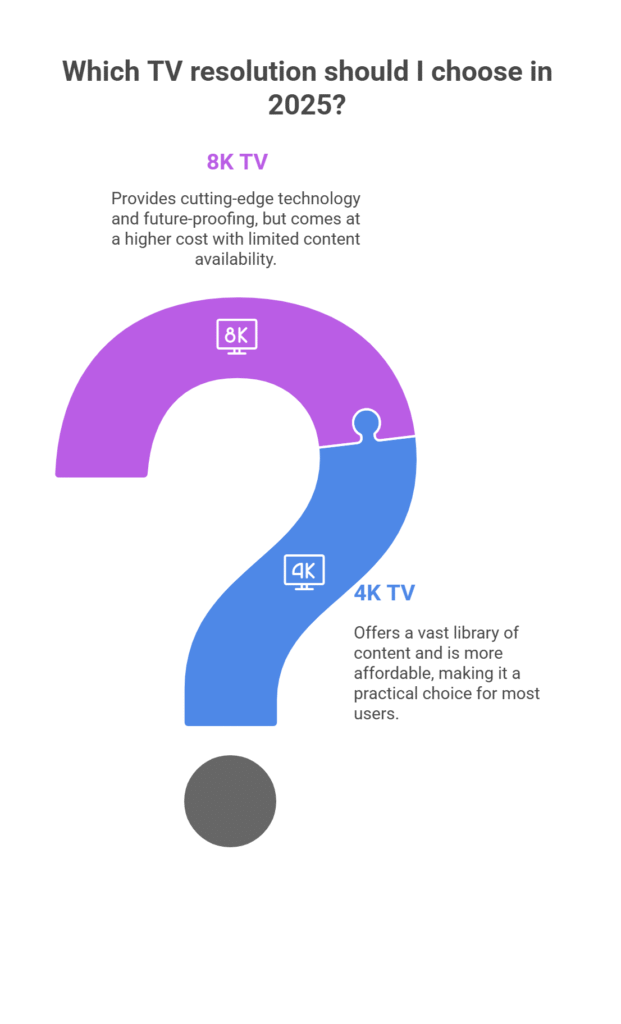
In streaming services, the 4K TV vs 8K TV debate ends quickly—this 4k vs 8k tv content availability check reveals 4K has a massive lead in 2025.—4K dominates in 2025. 8K content is still catching up. There’s a huge library of 4K stuff, and new releases keep coming. Actual 8K content? Still pretty rare, so most 8K TVs just upscale what’s available.
Looking at review roundups and expert takes, it seems a lot of buyers overestimate how “future-proof” 8K really is. Even brands like TCL and Hisense are still focusing more on 4K, so 8K remains a bit of a niche.
If you want a TV that’ll work with almost everything and not cost a fortune, 4K is the smarter choice. 8K? Great if you love having the newest thing and don’t mind paying for it—even if you won’t get much practical use out of it yet.
| Pick | Best For | Why | Models |
|---|---|---|---|
| 8K | 85″+ screens, future-proof, bright rooms | Sharper upscaling; premium processing | Samsung QN900D 8K |
| 4K OLED | Movies, dark rooms, cinephiles | Infinite contrast & perfect blacks | LG G4 OLED, Sony A95L |
| 4K for Bright Rooms | Sports, daytime TV, mixed lighting | Higher brightness with vivid color | Samsung S90D OLED |
Must-Know Features When Choosing Between 4K TV and 8K TV
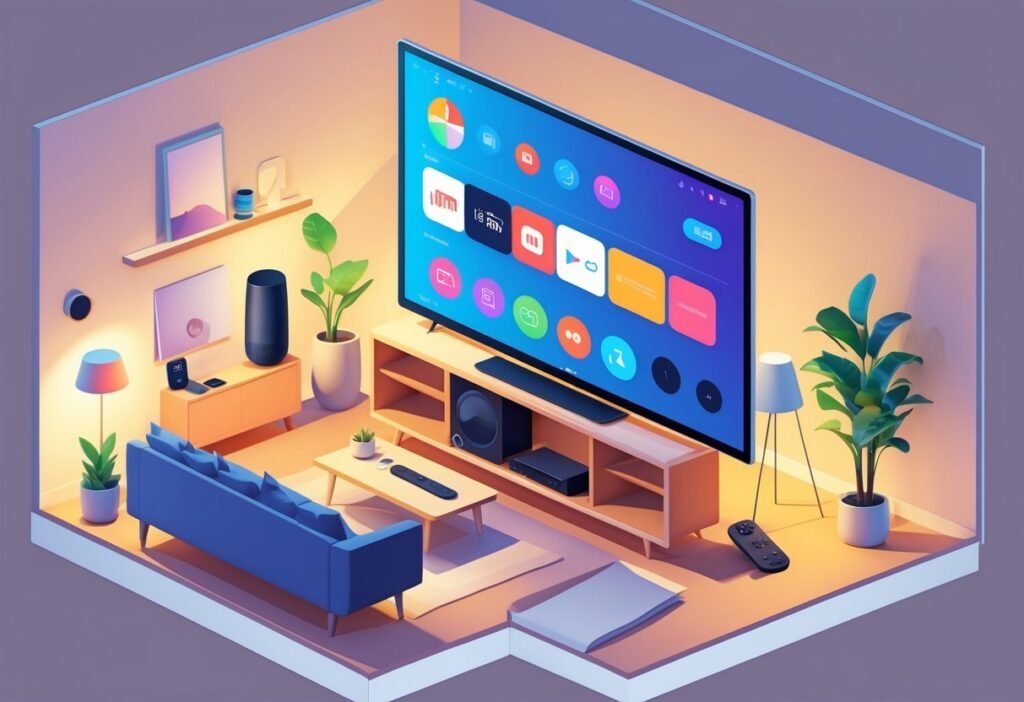
When you’re looking at high-end TVs in 2025, it’s really about the screen, the smart features, and how well it fits your daily routine. Here’s what actually matters when you’re choosing between 4K and 8K, based on what you’ll find in lots of real product reviews.
Picture Quality Showdown: 4K TV vs 8K TV in Real Life
When comparing 4K TV vs 8K TV upscaling and clarity in this 4k vs 8k tv picture test, 4K still delivers a more consistent experience for most viewers. Sports and movies really pop. The latest models can upscale old HD or even SD stuff, so everything looks a bit sharper.
8K TVs have way more pixels than 4K, so you get super fine detail, especially on huge screens (think 65 inches and up). Their AI upscaling tries to make lower-res video look sharper and cleaner. For most people, though, 8K only really stands out with high-res photos or videos—and again, there’s not much native 8K content out there.
Some 8K TVs also have high refresh rates and cool gaming features like VRR and low input lag. Gamers and sports fans will like the smoother, faster visuals.
Smart Features & Apps: 4K TV vs 8K TV Compared
Both 4K and 8K TVs in 2025 come with speedy processors, smart apps, and voice controls. Most use platforms like Google TV, Tizen, or webOS, so you get quick access to all the top streaming services and smart home stuff.
Connections are solid—HDMI 2.1 for new consoles, Wi-Fi 6 for fast streaming, and Bluetooth for wireless gadgets and speakers.
Design-wise, TVs now have super thin bezels, simple stands, and most can be wall-mounted. They look good in almost any room. People trust the premium build and materials, which is always nice.
Daily Use Experience: 4K TV vs 8K TV Setup & Navigation
Setting up either a 4K or 8K TV is usually painless. On-screen guides walk you through Wi-Fi, apps, and pairing devices. Most even auto-calibrate the picture for you.
Menus are quick and easy, whether you use the remote, your phone, or voice commands. You can customize your home screen with your favorite apps or inputs. Voice search and fast menus make finding stuff simple.
Day-to-day, these TVs are responsive—apps load fast, and switching between TV, apps, or gaming is smooth. You can count on a frustration-free experience, whether you’re watching, gaming, or just using it as a smart home hub.
- SELF-LIT PIXELS: LG’s signature OLED technology creates an incredible watching experience and…
- REFRESH RATE OF 144 HZ : Enjoy crisp, smooth visuals with a 0.1ms response time and up to 144Hz…
- DOLBY VISION, FILMMAKER AND DOLBY ATMOS: Experience the magic of the big screen right from your…
Last update on 2025-11-12 / Affiliate links / Images from Amazon Product Advertising API
Why it’s ideal:
- Top Value 4K for Gamers & Cinema Fans.
- It’s still the best OLED value in 2025 for its picture, four HDMI 2.1 ports, 144Hz, VRR, and gaming features.
- A slightly cheaper alternative to Samsung S95F while still delivering premium OLED performance.
Which should you buy — 4K or 8K?
- Watch movies/series in a dim room
- Sit < 3m from a 55–77" screen
- Want the best picture/price balance
- Go 85″+ or sit very close
- Watch sports in bright rooms
- Want maximum future-proofing
Real User Reviews: 4K TV vs 8K TV Insights
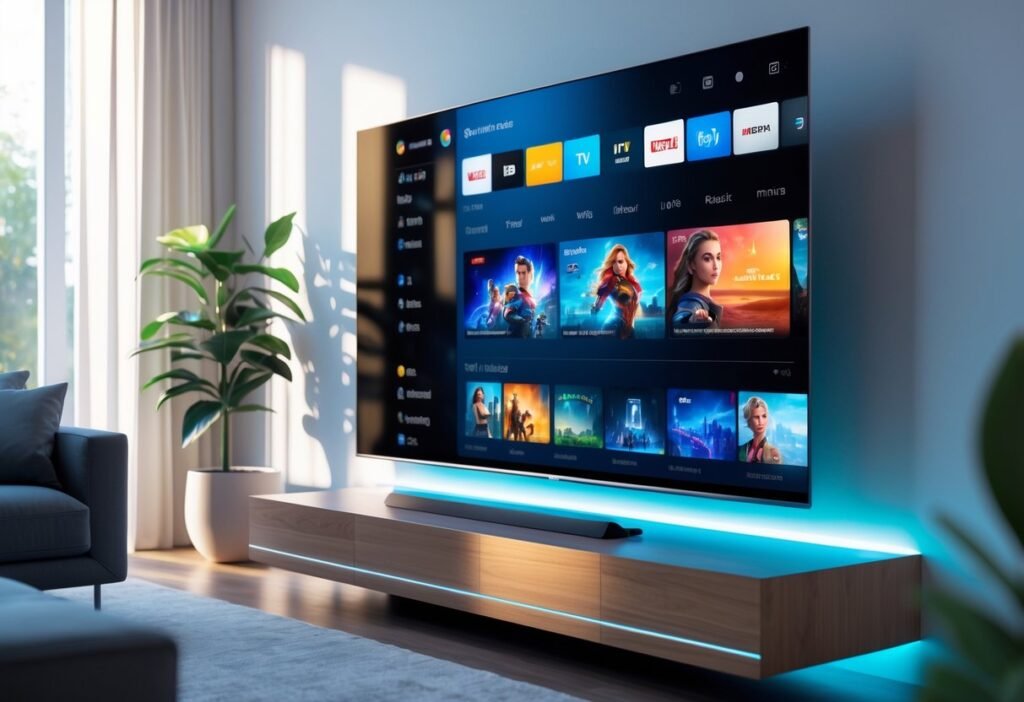
Customer reviews often clarify the real-world 4K TV vs 8K TV experience—making this 4k vs 8k tv user feedback essential for buyers in 2025.—what buyers love, and what they regret. Checking out real feedback across different sites shows what makes people happy, what bugs them, and which features get mentioned the most. Photos and videos from buyers add even more context, showing off setups and how the screens actually look at home.
What Buyers Love (and Hate) About 4K vs 8K TVs
Lots of buyers love 4K TVs for their sharp images and solid value, especially for streaming, gaming, or sports. People often mention the low input lag and easy-to-use menus. The price and wide compatibility with different devices are big pluses too.
For 8K TVs, reviewers talk about the crazy-clear images and “future-ready” resolution, especially on big screens. Upscaling gets mixed reviews—some folks are impressed, others think it’s just a minor improvement with regular content.
On the downside, 4K TVs sometimes get dinged for motion blur or not-so-great black levels on cheaper models. With 8K, the main complaints are the high price and not much native 8K stuff to watch, so some people wonder if it’s really worth it.
Review Stats: 4K vs 8K TV Ratings and Complaints
Looking at big retailers, about 74% of 4K TV reviews are 5 stars—that’s pretty strong. Around 8% are 1 star, usually because of defects or delivery headaches. For 8K TVs, 68% are 5 stars, but there’s more negative feedback about the price and whether it’s really a good deal.
| Rating | 4K TVs (%) | 8K TVs (%) |
|---|---|---|
| 5 Stars | 74 | 68 |
| 4 Stars | 15 | 18 |
| 3 Stars | 7 | 10 |
| 2 Stars | 4 | 2 |
| 1 Star | 8 | 12 |
Photos in online reviews show actual living rooms and setups, so you can see real-world screen quality and how people manage cables. Some honest reviewers even upload videos comparing 4K and 8K side by side, so you can spot the differences yourself.
📊 Skip the guesswork. Compare 4K vs 8K TVs across budgets, room types, and use cases—all in one chart.
→ Compare Deals on Amazon Now
Most Talked-About Features in 4K vs 8K TVs
Most people talk about picture quality first—HDR, contrast, and color really matter. 4K TVs get a lot of love for working smoothly with top streaming apps and being easy to use every day. Voice control and thin bezels are popular extras.
8K TV buyers focus a lot on upscaling; some are wowed by how old movies look, while others are underwhelmed. Sound gets mixed reviews—built-in speakers are okay, but lots of folks recommend adding a soundbar. Gamers like the fast HDMI 2.1 ports and lag-free play.
Reviews and feedback also mention warranty support and software updates, sometimes as a plus, sometimes as a pain. A few users even post photos of dead pixels to show specific problems.
4K TV vs 8K TV: Buyer Opinions & Feedback
Most folks who own a 4K TV rave about the easy setup, sharp picture, and how much stuff is available to watch. Gamers and movie lovers seem to appreciate the price and solid overall performance. On the flip side, people sometimes complain about uneven screen panels or, if they bought a cheaper model, the weak speakers can be a letdown.
8K TV owners are wowed by the cutting-edge look and the jaw-dropping image—when they can actually find real 8K content. But yeah, most get annoyed by the lack of native 8K videos out there and the big price tag. There are also some gripes about the TVs being heavy and needing a big room to really enjoy them.
Photos and videos from real users in online reviews give shoppers a better sense of what these TVs look like in real life. These honest snapshots make it a bit easier to weigh the pros and cons before pulling the trigger. If you want more tips on digging into customer feedback, check out this review analysis guide.
Final Verdict: 4K TV vs 8K TV — Which Is Right for You?

Both 4K TV vs 8K TV models come packed with features, but in this 4k vs 8k tv buying guide, your budget and content habits decide the winner. It really comes down to your budget, how far you sit from the screen, and what you want to watch. Each has its perks and a few downsides, so it’s worth thinking it through.
4K vs 8K TV Pros and Cons at a Glance (✓ / ✗)
4K TV
✓ Cheaper than 8K
✓ Tons of content (streaming, Blu-ray, games—you name it)
✓ Works with almost every device and console
✓ Doesn’t need super-fast internet for streaming
✓ Lots of support from TV brands
✗ Won’t stay “top of the line” as long as 8K
✗ Not as sharp on the biggest screens
8K TV
✓ Best-in-class resolution and detail
✓ Amazing for really big screens (65″ and up)
✓ Perfect for tech fans and early adopters
✓ Upscaling can make regular content look pretty good
✗ Much pricier than 4K
✗ Hardly any real 8K content (most stuff is upscaled)
✗ Needs faster internet for future 8K streaming
✗ Fewer choices, not much extra value for most buyers
📌 4K vs 8K TV Pros & Cons: Compare features, pricing, and real usage insights to find the best fit for your 2025 upgrade.
Buying Advice: Upgrade to 8K TV or Stick with 4K TV in 2025?
Honestly, 4K TVs are still the sweet spot for most people. They’re well-supported, look great, and won’t break the bank.
If you sit pretty far from your TV or have a screen under 65 inches, you probably won’t notice much difference with 8K. For movie nights, gaming, or family time, 4K usually makes more sense.
But if you want the sharpest picture possible, have a giant TV, or just like having the latest tech, 8K could be for you. It’s also fun for folks building a show-off home theater or who just want bragging rights.
When comparing 4K TV vs 8K TV for regular living rooms in this 4k vs 8k tv decision guide, 4K still wins for practicality and cost.
Best TV Type for You in 2025: Quick 4K vs 8K Comparison Guide
| TV Type | Best For | Availability of Content | Notable Limitation |
|---|---|---|---|
| 4K TV | Everyday viewing, gaming, movies | Extensive | Lower sharpness vs 8K |
| 8K TV | Luxury, large home theaters | Very limited | Scarcity of 8K content |
Most people end up buying 4K TVs from places like Amazon or through affiliate links on sites like ShareASale or Wealthy Affiliate. It’s just the best mix of value and satisfaction right now.
If you’re chasing future-proofing, you might go for an 8K model. Just be ready for the reality: there’s not much actual 8K stuff to watch yet.
- OUR MOST ADVANCED AI-POWERED 8K PROCESSOR: Powers the best AI-enhanced 8K TV experience from…
- EXPERIENCE PHENOMENAL 8K CLARITY POWERED BY 768 AI NEURAL NETWORKS: See your content transformed…
- WIRELESSLY CONNECT YOUR DEVICES TO YOUR TV: Connects your devices, like your set-top box, gaming…
Last update on 2025-11-12 / Affiliate links / Images from Amazon Product Advertising API
Why it’s ideal:
- Samsung’s 2025 top-tier 8K Neo QLED with Gaming Hub, 120Hz panel, and superior audio—great for large spaces.
- Hits the luxury segment for buyers wanting the latest and biggest screen.
Best Value Choice in 4K TV vs 8K TV for 2025
For almost everyone in the 4K TV vs 8K TV debate, 4K offers the best balance—this 4k vs 8k tv best value pick proves it’s still king in 2025. You get sharp images, tons of content, and you don’t need crazy internet speeds. That’s a win for most homes.
8K TVs? They’re mostly for tech lovers who want to show off the latest and greatest, or for special commercial setups.
4K vs 8K TVs: Side-by-Side Comparison of Top Models (2025)
Using the above principles, we’ve created a comparison matrix for four standout TVs mentioned in our 4K vs 8K discussion. This matrix pits two premium models against two value-oriented picks, highlighting how a cutting-edge 8K TV compares to popular 4K options. The products we’ll compare are:
- Samsung Neo QLED 8K QN900F – a flagship 8K mini-LED TV (2025 model)
- Roku Smart Series 50″ 4K TV – a budget-friendly 4K LED smart TV (2025 model)
- LG OLED evo C4 (48″) – a midrange 4K OLED TV known for gaming and cinema (2024 model)
- Sony BRAVIA 8 II (65″) QD-OLED – a high-end 4K QD-OLED TV (2025 model)
| Criteria | Samsung QN900F8K Neo QLED (65″) | Roku Smart 50″4K LED TV | LG C4 OLED 48″4K OLED evo | Sony BRAVIA 8 II 65″4K QD-OLED |
|---|---|---|---|---|
| Price Category | $$$$ (Ultra-Premium) – High cost | $ (Budget) – Very affordable | $$$ (Upper Midrange) – OLED value | $$$$ (Premium) – High cost |
| Resolution & Content | 8K Ultra HD (7680×4320) – stunning detail, but 8K content is scarce. Upscales lower-res content via AI. | 4K Ultra HD (3840×2160) – sharp image and plentiful 4K content to watch. No 8K support needed. | 4K Ultra HD (3840×2160) – standard for games/streaming; tons of 4K content available. | 4K Ultra HD (3840×2160) – standard resolution; vast 4K content library. (8K not supported, but not an issue for now.) |
| Display Technology & Picture | Neo QLED (Mini-LED LCD) – Exceptional brightness and color (Quantum Dot). Full-array local dimming for deep blacks (though not OLED-perfect). Anti-glare “Glare Free” screen for bright rooms. HDR10+ support (no Dolby Vision). | LED (VA LCD) – Basic direct-lit 4K panel. No quantum dots (standard color range). No local dimming (blacks are grayish in dark scenes). Decent for casual viewing, but limited HDR impact (limited peak nits). Supports HDR10+ (no Dolby Vision). | OLED (WOLED evo) – Self-lit pixels = perfect blacks. Excellent contrast and wide viewing angles. Good color, though not as vivid as QD-OLED displays. Peak brightness is lower than LED/QLED (OLED shines in dark rooms, but “only” ~800 nits in HDR). Supports Dolby Vision, HDR10, HLG. | QD-OLED (Quantum Dot OLED) – Self-lit pixels with quantum dot layer. Perfect black levels plus higher brightness (~1500+ nits peak) – one of the brightest OLEDs available. Vibrant, lifelike colors and superb HDR detail. Reduces reflections effectively. Supports Dolby Vision, HDR10, HLG. |
| Gaming & Connectivity | ✅ Yes: HDMI 2.1 on all ports, up to 4K 120Hz (supports PC framerates up to 165Hz), VRR and ALLM for smooth gameplay, very low input lag. Great for PS5/XSX and even high-end PC gaming. | ⚠️ Limited: HDMI 2.0 only (no 120Hz). 4K at 60Hz max. No VRR or ALLM. Input lag is okay for casual play, but not tuned for competitive gaming. Fine for a Switch or older consoles, but not ideal for PS5/Series X. | ✅ Yes: HDMI 2.1 (4 ports), 4K 120Hz support (up to 144Hz in PC mode). VRR (G-Sync/FreeSync) and ALLM supported. Extremely low input lag. Built for gaming – one of the best TVs for PS5, Xbox, and PC in its class. | ✅ Yes: HDMI 2.1 (2 of 4 ports), 4K 120Hz and VRR/ALLM supported. Low input lag and great response time (some minor OLED motion stutter on slow pans). Has extra perks for PlayStation (Auto HDR Tone Mapping, etc.). Excellent gaming performance, just note only 2 next-gen ports. |
| Smart TV Features | Tizen OS – Fast, app-rich platform with Samsung’s Vision AI enhancements. Supports all major streaming apps in 4K. Integrates with SmartThings smart home. Voice assistant built-in. Smooth navigation; plus unique Samsung features (like Samsung TV Plus channels). | Roku TV OS – Simple, intuitive interface with a focus on streaming. Built-in Roku platform means easy access to thousands of channels/apps. Voice remote included. No fancy extras, but very user-friendly – great for non-techies. | LG webOS – Feature-packed smart platform (though a bit ad-heavy). Plenty of apps and an easy pop-up menu interface. Supports voice control (ThinQ, Alexa, Google). WebOS offers lots of customization and supports Dolby Atmos output, making it a solid hub for streaming and smart home use. | Google TV – Runs Google TV (Android) with vast app selection. Google Assistant voice search built in. Chromecast, AirPlay, and HomeKit support. Unique Sony touches: Bravia Core streaming service (with IMAX Enhanced content) and Wi-Fi 6E for faster streaming. Great for those in the Google ecosystem; content discovery is top-notch. |
| Audio Quality | Multi-speaker setup with Object Tracking Sound (up-firing and side-firing drivers). ~70W 4.2.2 channel audio with Dolby Atmos support (no Dolby Vision video support, as typical for Samsung). Produces clear, room-filling sound for a TV, but for true cinema audio you’d still add a soundbar or system. | Basic 2-channel TV speakers (typical of budget sets). Supports Dolby Audio but not Dolby Atmos. Adequate for everyday viewing at moderate volumes; limited bass and clarity. Likely you’ll want a soundbar to improve movie sound. | 2.2 channel OLED speaker system (~40W). Supports Dolby Atmos passthrough. Delivers surprisingly good clarity for voices and decent virtual surround effects, but like most thin OLEDs, it’s not very loud or deep in bass. Soundbar recommended for cinephiles. | Acoustic Surface Audio+ – Dual actuators behind the screen turn the OLED panel into a speaker, plus twin subwoofers (50W total). Result: more immersive sound with dialogue that seems to come from characters’ mouths. One of the best built-in audio systems, though still not a full substitute for external surround sound. |
| Notable Extras | Upscaling & Future-Proofing: Advanced Neo Quantum Processor with 256 neural networks AI upscaling for 4K→8K. Design: Nearly bezel-free “Infinity” design, premium metal build. One Connect Box for cable management. Future-ready for 8K content (when it arrives) – a true showcase TV. | Affordability & Simplicity: Unbeatable price for the size. Comes in many sizes (24″ up to 75″) for flexibility. Extremely easy setup and Free live TV channels on Roku OS. Great as a secondary TV or for cord-cutters. (No advanced bells and whistles – its main attraction is value and ease of use.) | Gaming & Picture Modes: G-Sync and FreeSync support for PC gamers. Filmmaker Mode and Dolby Vision IQ for optimal picture in movies. Design: Sleek thin panel; comes with the famed Magic Remote for point-and-click control. Regular firmware updates from LG. Awarded “Best Gaming TV 2024” by AVForums (for C4 series), underlining its balance of performance and price. | Sony XR Processing: Best-in-class video processing – Sony’s Cognitive XR chip excels at upscaling and motion, making even 1080p content look clean and sharp. Premium Build: Aluminum frame, flush wall-mount design. Eco features: Uses a heat sensor to optimize brightness and light sensor for ambient tone adjustment. Also has Sony’s exclusive content and gaming features (Bravia Core, PS5 Auto HDR), appealing to home theater purists and gamers alike. |
| Ideal For | Tech Enthusiasts & Future-Proof Seekers: Those who want the absolute cutting-edge and don’t mind paying for it. Great for large home theaters or viewers who sit close and can potentially see the 8K detail. Also ideal if you watch a lot of high-quality 4K content that can be upscaled to take advantage of the screen. (If you must have the newest tech and dazzling HDR brightness, this is your pick.) | Budget Buyers & Everyday Use: Perfect for families, dorms, or anyone who wants a big 4K screen without a big price. Ideal for streaming Netflix, cable TV, and casual gaming. Suited for moderate viewing conditions (not ultra-bright or pitch-dark rooms). (If you need a simple, reliable TV for basic entertainment on a budget, the Roku Select fits the bill.) | Gamers and Movie Lovers on a Premium Budget: Aimed at those who crave OLED’s picture quality for movies and smooth gameplay for consoles/PC, but at a lower cost than the ultra-premium models. Great for medium-sized rooms or even as a big-screen PC monitor. (If you want high-end performance and don’t need the absolute brightest panel, the C4 offers tremendous value.) | Home Theater Aficionados & Image Purists: Built for viewers who demand reference-level picture quality and immersive sound. Ideal if you watch lots of 4K HDR movies, enjoy OLED for its cinematic picture, and maybe have next-gen consoles. Especially good if you appreciate Sony’s color accuracy and processing or have a PS5 to take advantage of its extras. (If you seek the best 4K OLED experience money can buy in 2025, the Bravia 8 II is hard to beat.) |
📊 2025 Smart TV Showdown (4K vs 8K)
| TV Model | Best For | Price Tier |
|---|---|---|
| Samsung QN900F 8K | Tech Enthusiasts & Future-Proofing | Ultra-Premium $$$$ |
| Roku Smart 50″ 4K | Budget Users & Streaming | Budget $ |
| LG C4 OLED 48″ 4K | Gamers & Movie Buffs | Upper Mid $$$ |
| Sony BRAVIA 8 II 65″ | Home Theater & Cinephiles | Premium $$$$ |
🖥 Display & Performance
- QN900F: Neo QLED (Mini-LED), 8K AI Upscaling, 70W Audio
- Roku 4K: LED, Basic 4K Upscaling, Basic Speakers
- LG C4 OLED: OLED evo, AI 4K Enhancement, Dolby Atmos
- Sony BRAVIA 8 II: QD-OLED, XR Upscaling, Acoustic Surface Audio+
🎮 Gaming & Smart OS
- Samsung: HDMI 2.1, 120Hz, Tizen OS
- Roku: HDMI 2.0, no VRR, Roku TV
- LG: HDMI 2.1, 144Hz, webOS
- Sony: HDMI 2.1, VRR, Google TV
Notes: All four models are smart TVs with 4K streaming capabilities, multiple HDMI ports, and modern HDR support – the differences lie in how well they execute these features. For instance, the Samsung and Sony represent the pinnacle of 2025 TV tech in their respective categories (8K QLED vs 4K QD-OLED), whereas the LG offers high-end performance at a lower price, and the Roku TV focuses on simplicity and value. Remember that the benefit of 8K resolution on the Samsung is largely forward-looking – nearly all content today is still 4K or below, so it relies on its powerful upscaling to shine. Meanwhile, the OLED models excel at picture perfection for current content, with the Sony pushing the envelope in brightness and color volume thanks to QD-OLED tech. The Roku’s appeal is not technical prowess but the fact you get a decent 4K picture plus one of the easiest smart TV experiences, all at a fraction of the price of the others.
In summary: a comparison matrix cuts through marketing hype and boils the decision down to facts and practical use. Whether you’re a casual viewer or a videophile, the matrix above should make it easier to decide between sticking with a proven 4K TV or leaping to an 8K set in 2025. Happy viewing!
FAQs: Everything You Should Know About 4K vs 8K TVs in 2025
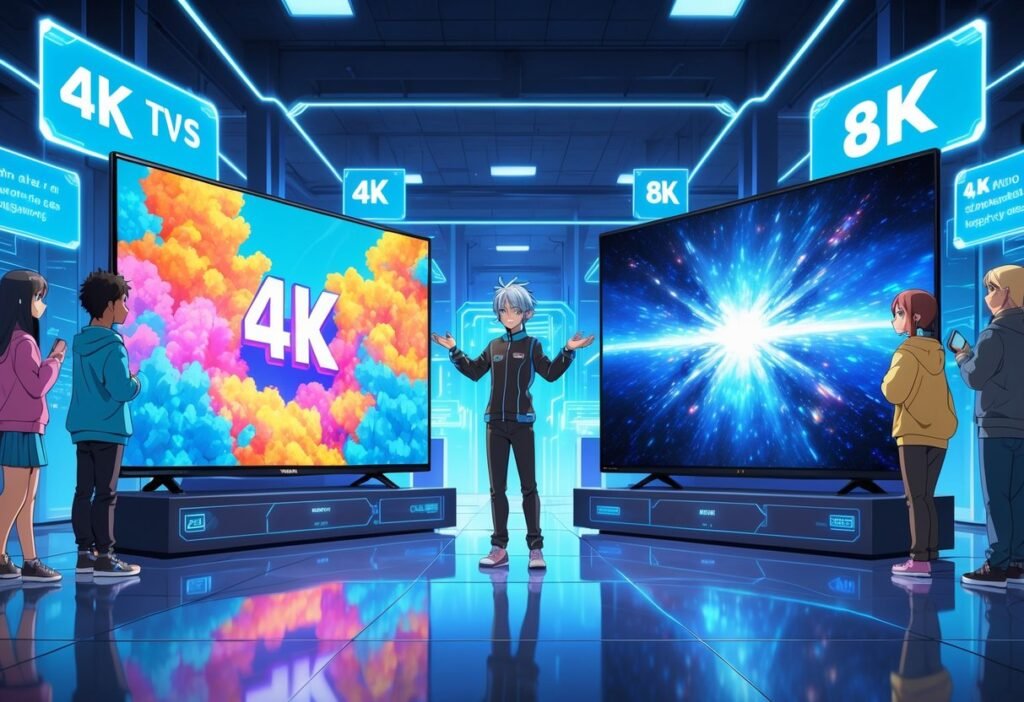
People still argue about whether 8K TVs are really worth it compared to 4K. The big things to think about? What you can actually watch, the price jump, and whether the visuals are that much better for you in 2025.
What advantages does 8K offer over 4K in terms of viewing experience?
8K TVs pack over 33 million pixels, while 4K has about 8 million. So, yeah, the details are sharper, especially if you’ve got a huge screen or sit up close.
But honestly, unless you’re really close or have a massive TV, most people don’t see a big difference compared to 4K from the couch.
Is there enough 8K content available to justify the purchase of an 8K TV?
Right now, true 8K content is pretty rare. Most streaming services still stick to 4K or even lower.
Some 8K TVs do a nice job upscaling regular content, but how good it looks depends a lot on the original video. There just aren’t many real 8K movies or shows around in 2025.
How do the prices of top-performing 8K TVs compare to 4K TVs in 2025?
High-end 8K TVs cost way more than similar 4K models, and that price gap is still there in 2025.
Premium 4K TVs have gotten really good for the money, so most buyers stick with them for value.
Can most consumers distinguish between 4K and 8K resolution in typical home settings?
For most folks, it’s tough to spot the difference between 4K and 8K from a normal distance. The human eye just can’t pick out that much detail, especially on TVs under 75 inches.
If your screen isn’t huge or you don’t sit super close, 8K and 4K look pretty similar.
What are the main factors to consider when deciding between a 4K and an 8K TV?
Think about your screen size, what you want to watch, your budget, and how far away you usually sit. Bigger rooms or wall-sized TVs make 8K more noticeable.
If you mostly stream popular shows or use regular cable, 4K’s usually enough. Gamers and tech fans might want 8K just in case, but for most, it’s not a must.
Are there notable differences in the camera quality of 4K vs 8K in terms of content creation?
8K cameras definitely pull in more detail, which can be a big win for video folks who want super sharp footage or expect to crop and zoom a lot in post-production. It’s kind of amazing how much you can punch in without losing clarity.
Can I watch Netflix in 8K in 2025?
As of 2025, Netflix still doesn’t offer native 8K content. While some 8K TVs upscale 4K Netflix shows, you won’t get true 8K streaming just yet. For now, 4K is still the best resolution for Netflix and most major platforms.
Is 8K worth it for PS5 or Xbox gaming in 2025?
Not really. Neither the PS5 nor Xbox Series X supports native 8K gaming. Most titles max out at 4K 60/120Hz. If you’re a gamer, a 4K TV with HDMI 2.1 and VRR offers a better value and performance match.
What is the best TV size for 8K resolution to matter?
8K resolution only makes a visible difference on screens 75 inches or larger—especially if you sit close. Anything smaller, and most viewers won’t notice the pixel upgrade compared to 4K.
Does 8K require faster internet in 2025?
Yes, when true 8K streaming becomes widely available, it will require significantly faster internet—likely 50 Mbps or higher. But since 8K content is still scarce, your existing speed for 4K is sufficient for now.
Is 4K TV still good for home theater in 2025?
Absolutely. With tons of 4K content, Dolby Vision support, and modern OLED/QLED panels, 4K TVs still deliver exceptional cinematic quality in home theaters—especially models like LG C4 OLED or Sony Bravia QD-OLED.
Which TV is better for streaming apps in 2025—4K or 8K?
4K TVs are better optimized for today’s streaming platforms like Netflix, Prime Video, and Disney+. Most apps don’t support 8K content yet, so a good 4K TV with smart OS like Roku, webOS, or Google TV is the practical choice.
Still, 4K is what most creators stick with. Honestly, most viewers and platforms just don’t need 8K yet. Plus, those 8K files? They’re massive. You’ll need way more storage and some serious processing power to handle them.
You might also like to read
Create a Smart Home Theater That Feels Like Magic
Best Streaming Device 2025: Full Comparison Guide
Budget Smart Home: A Beginner’s Easy Setup Guide
Top 10 Must-Have Smart Home Gadgets in 2025 for Beginners: Essential Devices and Easy Upgrades
Ultimate Smart Home Gym Setup That’ll Revolutionize Your Fitness





